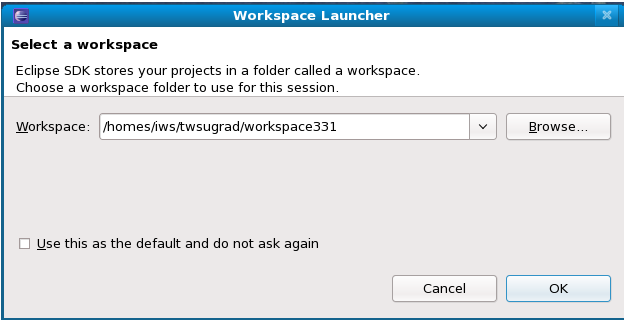
This handout describes how to perform common Java development tasks in Eclipse and on the command-line.
Contents:
A few CSE 331 tasks require connecting to a Linux machine and running some commands from the command-line. To understand the instructions may require some basic understanding of how to use a shell to perform command-line actions. This material is covered (in more depth than we need) in CSE390A, which has materials posted online. Alternately, you can read the Unix tutorials provided by the student ACM chapter. While these tutorials are old and have some dated information about machine names and such, the basics of the Unix command line have not changed in decades.
If you are working on your own computer, you should have installed Eclipse. Else, it is installed on the department machines (and virtual machine).
Type this at the prompt to start Eclipse on Linux:
eclipse &
Eclipse will start up, display a splash screen, and then show a workplace selection dialog:

Eclipse is asking you which workspace folder to use for this session. In response, if in the department labs, type:
/homes/iws/YourUserName/workspace331
where YourUserName is your UW CSE username. (Note: Do not enter "~/workspace331" for this step. Eclipse does not recognize the '~' character.) On your own machine, you can choose where to put your workspace.
If Eclipse shows the welcome screen, containing only the text "Welcome to the Eclipse IDE for Java Developers" on a pretty background, switch to the code editor by going to Window > Open Perspective > Other... and selecting Java (default).
From the start menu, goto: All Programs » DEV TOOLS & LANGUAGES » Eclipse » eclipse.
Eclipse will start up, display a splash screen, and then show a workplace selection dialog:
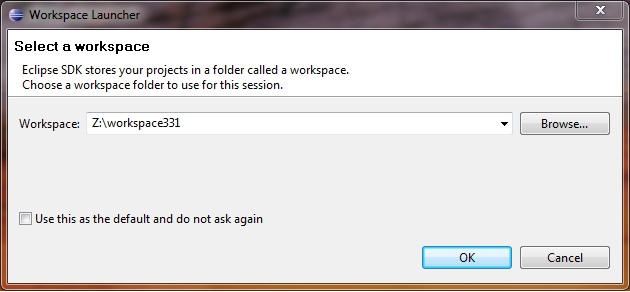
Eclipse is asking you which workspace folder to use for this session. In response, type:
Z:\workspace331
This directory will work on the lab Windows computers; adjust it as needed if you are working on your personal computer.
In the Formatter preferences, in the Comments tab, unselect the "enable block comment formatting" checkbox.
To use the Ant buildfile, you need to tell Eclipse to use the Java JDK (development kit) instead of the JRE (runtime environment).
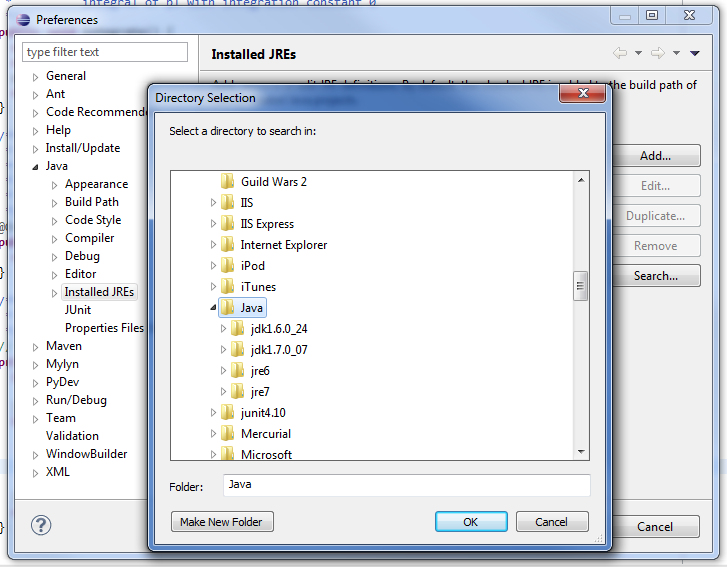
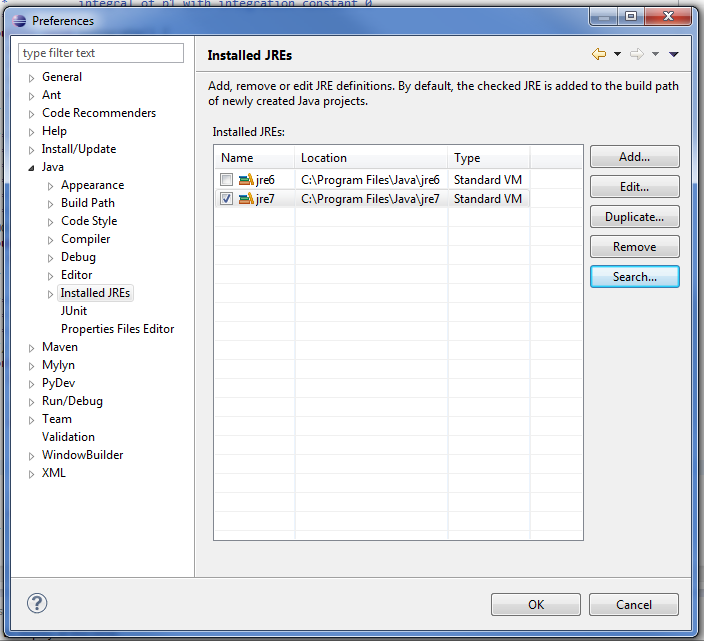
We expect your code to not have any generics-related problems. For example, the following code is unacceptable:
List myList = new ArrayList();
myList.add("foo");
The generic type List of myList should be parametrized, for instance, to String by replacing the first line with List<String> myList = new ArrayList<String>(); Note that List<String> myList = new ArrayList(); is also incorrect.
By default, Eclipse shows generics problems as warnings (indicated by yellow lines and markers). You can configure Eclipse to instead issue errors (indicated by red lines and markers) for these problems. Doing so will help you remember to write acceptable generics code.
To make this configuration, go to Windows » Preferences and select Java » Compiler » Errors/Warnings. Under Generic types, change the value of Unchecked generic type operation to Error.
(Note that there is another setting named Usage of a raw type that is set to Ignore by default. We recommend leaving this option disabled or set simply to Warn because it is specific to the Eclipse compiler and checks for more stringent requirements than required by the Java language specification. Thus, "Usage of raw type" may complain about issues, that while providing insight about your code, is not checked by Oracle's javac, which is our official standard for compilation errors and warnings in this class.)
Switch to the "Java" perspective in Eclipse if you're not already in it (Window » Open Perspective » Other... » Java).
You can open multiple files in Eclipse by double-clicking each of them from the Package Explorer pane. Once you have multiple files open, you can switch between them quickly by holding down Ctrl and hitting F6 to bring up a dropdown box of open files, and then using the arrow keys to select the file whose editor you wish to bring into focus. You can also navigate through different files using the tabs on top of the editor pane.
To create a new Java source file (with the .java extension), select from the top menu File » New » Class. A window will pop up, asking you details about the class. Leave the source folder as cse331/src, and select a package (e.g. hw1). Choose a name for your class (e.g. MyClass) Type this name in the "Name" field and click Finish.
(If you want your new class to be executable, it will need a main method. Eclipse can generate that automatically for you if you check the appropriate checkbox in the New Java Class screen.)
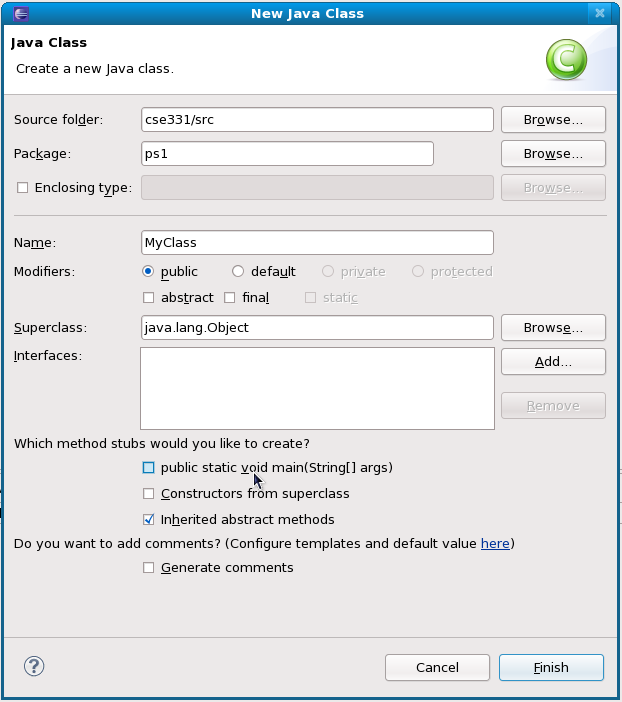
There is a similar procedure for creating new non-Java files such as text files. Select File » New » File. In the resulting dialog box, choose the parent directory of your new file and type the desired filename. If you want to create a new directory, you can do so by appending the directory name in front of your desired filename. For example, if you want to create a file problem0.txt in the directory hw1/answers, but the answers directory does not yet exist, you can choose hw1 as the parent directory, and then type answers/problem0.txt as the file name, and Eclipse will create the new directory and file for you.
Here are some useful actions that you can perform when editing Java code:
Autocompletion is the ability of an editor to guess what you are typing after you type out only part of a word. Using autocompletion will reduce the amount of typing that you have to do as well as the number of spelling mistakes, thereby increasing your efficiency.
Eclipse continuously parses your Java files as you are editing, so it is aware of the names of variables, methods, etc... that you have declared thus far.
CTRL+Space can be used to autocomplete most things inside the Eclipse Java editor. For example, if you have declared a variable named spanishGreeting in the current class, and have typed the letters spanishGree in a subsequent line, Eclipse can infer that you mean to type spanishGreeting. To use this feature, press CTRL+Space while your cursor is at the right of the incomplete name. You should see spanishGree expand to spanishGreeting.
Eclipse can also help you autocomplete method names. Suppose you have a variable myList of type List, and you want to call the method clear. Begin typing "myList." — at this point, a pop-up dialog will display a list of available methods for the type List, and you can select the appropriate method with the arrow keys. You can force the popup to appear with CTRL+Space.
You can press CTRL+SHIFT+o to organize your imports in a Java file. Eclipse will remove extraneous import statements and try to infer correct ones for types that you refer to in your code but have not yet been imported. (If the name of the class that needs to be imported is ambiguous – for example, there is a java.util.List as well as a java.awt.List – then Eclipse will prompt you to choose which one to import.)
Although you can directly browse the Java 7 API and other documentation at the Oracle website, it is often useful to be able to cross-reference parts of your code with the appropriate documentation from within your editor.
To view the documentation of a class that is referred to in your code, place your cursor over the class's name, and press SHIFT+F2. A web browser window will be opened to the class's documentation page. If the class is provided by Java, the documentation page will be on Oracle's website.
For your own classes, you will need to tell Eclipse where to find their documentation. To do so, right click on the project name (e.g. cse331) in the Package Explorer pane and click "Properties". Select "Javadoc Location" in the left pane. Select the location, e.g. "file:/homes/iws/YourUserName/workspace331/cse331/doc/". (Note: the "file:" portion is important, since the location is expected to be recognizable by a web browser.) After setting the Javadoc location path, click OK. (If on your own machine, modify the path above appropriately.)
Ant is a tool that can be used to automate many common tasks, such as compiling, testing, and running code. It is also used to validate a CSE 331 assignment submission. The instructions for Ant are stored in a “buildfile” named build.xml in each assignment's directory.
The buildfile specifies a set of targets that it supports, such as build and test. Note that the “help” target will output information about the supported targets in our buildfile. The validate target works only on attu.
To run Ant for assignment N from the command line, do the following:
cd ~/workspace331/cse331/src/hwN ant target
To run Ant in Eclipse, right click cse331/src/hwN/build.xml in the Package Explorer, where N is the desired assignment number. Now right click Run As » Ant Build... and in the resulting window, go to Targets and select the desired target(s).
There is a button near the left-hand side of the Eclipse toolbar
that looks like ![]() which will re-run the last
ant target (or other external tool) that you ran. The drop down
button will let you easily re-run a number of ant targets.
which will re-run the last
ant target (or other external tool) that you ran. The drop down
button will let you easily re-run a number of ant targets.
You must compile your source code before running it. The javac compiler is used to transform Java programs into bytecode form, contained in a class file. Class files are recognized by their .class extension. The bytecode in class files can be executed by the java interpreter.
To compile all source files for a particular assignment, change your current directory to ~/workspace331/cse331/src/hwN/, where N is the desired assignment number. Now type on the command-line:
ant build
This will run an Ant script that uses the instructions denoted in build.xml to compile all the .java files into corresponding .class files. Note that if one or more of your files do not compile, you will receive error messages and no .class files will be generated for the files that do not compile properly.
If you would like to manually compile files without the use of an Ant script, you can use javac to compile one or more source files into class files for execution by the Java interpreter. The following commands:
cd ~/workspace331/cse331/src javac -Xlint -d . -g [more options] hwN/file1.java hwN/file2.java ...
will generate class files hwN/file1.class, hwN/file2.class, etc., for each specified source file. Type "man javac" at the attu prompt for more information on javac options. You should almost always use the -g option, which will provide improved debugging output, and also the -Xlint option, which provides stricter compiler warnings.
Eclipse is set up by default to automatically recompile your code every time you save. Classes with compile errors are marked in the Package Explorer with red cross marks. The compile errors, as well as compile warnings, also appear in the Problems view (usually situated at the bottom panel of Eclipse).
If your file is saved and Eclipse says that it does not compile but you believe that it should, make sure that all of the files on which your file depends are saved and compiled. If that does not work, try refreshing your project or using Project » Rebuild Project to force Eclipse to recognize the latest versions of everything.
To compile with Ant in Eclipse, right click cse331/hwN/build.xml in the Package Explorer, where N is the desired assignment number. Now right click Run As » Ant Build... and in the resulting window, go to Targets and select build in the list of targets.
Once you have compiled your source code into class files, you can execute it with the Java interpreter.
Typically, to run a program you will just type ant on the command line, possibly with a more specific target: ant target. However, you can also invoke the Java virtual machine directly via the java program.
Here is how to run Java programs from the command-line:
cd ~/workspace331/cse331/src java -ea hwN.theClassYouWantToRun
(The -ea flag enables assertions.)
For example, if you wish to run the PolyGraph class from hw1, you would run:
java -ea hw1.PolyGraph
Note that you do not include .java or .class at the end of the class name.
To run a program, right click on the Java source file containing the main() method and choose Run As... » Java Application.
There is also a button near the left-hand side of the Eclipse
toolbar that looks like ![]() which will re-run the
last application (or JUnit test, see below) that you ran.
which will re-run the
last application (or JUnit test, see below) that you ran.
JUnit is the testing framework that you will use for writing and running tests.
For more information, visit:
The test Ant target can be used to test SpecificationTests and ImplementationTests.
To run JUnit without using Ant, change to the ~/workspace331/cse331/src directory and invoke java org.junit.runner.JUnitCore for the text interface with the name of the test class as a parameter. For example, if I wanted to run RatTermTest, I could type:
cd ~/workspace331/cse331/src java org.junit.runner.JUnitCore hw1.test.RatTermTest
JUnit is integrated with Eclipse, so you can run the test suite from within the IDE.
If you are not working at UW CSE, you might have to explicitly add the junit-4.11.jar library using Project » Properties » Java Build Path » Libraries » Add External JARs and then telling Eclipse where your copy of junit-4.11.jar is located.
Because your JUnit tests will likely have different class and method names than those of your classmates, there needs to be a standardized way of accessing every student's tests. Thus, each assignment comes with the JUnit test classes hwN.test.SpecificationTests and hwN.test.ImplementationTests. You will load all the JUnit tests you wrote in one of these two test suites.
hwN.test.SpecificationTests, as it name suggests, should contain only specification tests — that is, those tests that check only for features implied by the specification. Consequently, your specification tests should be valid tests for any other person's code that claims to satisfy the same specification, even if that implementation is inherently very different.
Conversely, hwN.test.ImplementationTests should contain implementation tests — that is, those tests that test only details that are specific to your implementation.
As an example, suppose you were implementing the following specification:
/** Frobs the blarghnik. * @requires b != null */ public void frob(Blarghnik b);
A specification test should never pass in a null parameter to this method — this would violate the specified pre-condition. However, your particular implementation might check for the null parameter and throw a NullPointerException. Your implementation test can safely exercise this case by passing in null.
Similarly, an iterator specification which does not specify the order in which elements are returned indicates that no specific order should be assumed in a specification test. Your implementation may happen to keep elements in a sorted list, and so your implementation test may wish to check that the elements returned by the iterator are sorted.
Before your submit each assignment, you should ensure that your code
passes both the SpecificationTests and
ImplementationTests test suites. We have provided a
convenient way to run
these tests in each assignment's build file in
~/workspace331/cse331/src/hwN/build.xml.
The test target will run hwN.test.SpecificationTests and
hwN.test.ImplementationTests. The validate
target runs these tests on a fresh copy of your code it checks out
from your repository.
Oracle's Java Development Kit includes javadoc, a tool that produces specifications from source code annotated with special comments. The comments may include "tags", which are introduced by an at-sign (@).
We have an extended javadoc program that recognizes additional CSE 331 tags, as well as all the tags accepted by the Oracle Standard Doclet. These additional tags declare specification fields for classes and requires, modifies, and effects clauses for methods. Note that these tags must appear after all non-tag comments for classes and methods.
| @specfield name : T // text | Indicates that name is a abstract specification field of type T for the class, adding text as a comment if present |
| @derivedfield name : T // text | Same as specfield, except that this also adds the property "derived" to the output information |
Derived fields can be viewed as functions on preexisting state; thus if a class had a specfield @specfield n : integer we could define a derived field:
@derivedfield pos : boolean // pos = true iff n > 0
Derived fields are not allowed to hold any information that could not be already calculated from the already existing state in the object. Thus, you use specfields to introduce new state variables and derived fields to introduce functions on those state variables.
Derived fields are not strictly needed in specifications, but they may reduce complexity and redundancy.
| @requires X | Declares X to be a precondition for the method |
| @modifies Y | Declares that nothing besides Y will be modified by the method (as long as X holds when it is invoked) |
| @effects Z | Declares that Z will hold at exit from the method (as long as X holds when it is invoked) |
The preferred way to generate API documentation with the CSE 331-extended javadoc is to use the ant doc target for your assignment. See running automated tasks with ant in the "editing, compiling, running and testing" handout. The instructions for eclipse, briefly:
After running the ant doc target, you should check the output. You may find that you need to add line breaks (<br>) or paragraph breaks (<p>) to your javadoc comments for readability. Also, if you omit certain tags, subsequent text may fail to appear in the output. Finally, since much of the text of javadoc comments is inserted in a HTML document, you must be careful with text that can be interpreted as HTML markup, such as the less-than (<) and greater-than (>) characters. For instance, if you write:
@effects Adds <x> and <y>
then <x> and <y> will be interpreted as HTML tags in the output (and won't be displayed by a browser). It's usually better to just write
@effects Adds x and y
Report any weird behavior or complaints about javadoc to cse331-staff@cs.washington.edu.